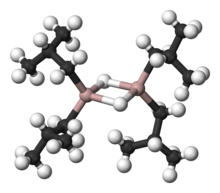This is an old revision of this page, as edited by Citation bot 1 (talk | contribs) at 16:15, 19 June 2011 (Add: issue. Tweak: pages, issue. Formatted dashes.). The present address (URL) is a permanent link to this revision, which may differ significantly from the current revision.
Revision as of 16:15, 19 June 2011 by Citation bot 1 (talk | contribs) (Add: issue. Tweak: pages, issue. Formatted dashes.)(diff) ← Previous revision | Latest revision (diff) | Newer revision → (diff) | |
 | |
| Names | |
|---|---|
| IUPAC name Diisobutylaluminum hydride | |
| Other names DIBAH; DIBAL; DiBAlH; DIBAL-H; DIBALH | |
| Identifiers | |
| CAS Number | |
| 3D model (JSmol) | |
| ChemSpider | |
| ECHA InfoCard | 100.013.391 |
| CompTox Dashboard (EPA) | |
InChI
| |
SMILES
| |
| Properties | |
| Chemical formula | C16H38Al2 (dimer) |
| Molar mass | 142.22 (monomer) |
| Appearance | colorless liquid |
| Density | 0.798 g/cm |
| Melting point | –18 °C |
| Boiling point | 116–118 °C/1 mmHg |
| Solubility in water | hydrocarbon solvents |
| Hazards | |
| Occupational safety and health (OHS/OSH): | |
| Main hazards | ignites in air |
| Except where otherwise noted, data are given for materials in their standard state (at 25 °C , 100 kPa).
| |
Diisobutylaluminium hydride, DIBAL, DIBAL-H or DIBAH, is a reducing agent with the formula (i-Bu2AlH)2, where i-Bu represents isobutyl (-CH2CH(CH3)2). This organoaluminium compound was investigated originally as a co-catalyst for the polymerization of alkenes.
Properties
Like most organoaluminum compounds, the compound’s structure is probably more than that suggested by its empirical formula. A variety of techniques, not including X-ray crystallography, suggest that the compound exists as a dimer and a trimer, consisting of tetrahedral aluminium centers sharing bridging hydride ligands. Hydrides are small and, for aluminium derivatives, are highly basic, thus they bridge in preference to the alkyl groups.
DIBAH can be prepared by heating triisobutylaluminium (itself a dimer) to induce beta-hydride elimination:
- (i-Bu3Al)2 → (i-Bu2AlH)2 + 2 (CH3)2C=CH2
Although DIBAH can be purchased commercially as a colorless liquid, it is more commonly purchased and dispensed as a solution in organic solvents such as toluene.
Use in organic synthesis
DIBAH is useful in organic synthesis for a variety of reductions, including converting esters and nitriles to aldehydes. DIBAH efficiently reduces α-β unsaturated esters to the corresponding allylic alcohol. By contrast, LiAlH4 reduces esters and acyl chlorides to primary alcohols, and nitriles to primary amines . DIBAH reacts slowly with electron-poor compounds, and more quickly with electron-rich compounds. Thus, it is an electrophilic reducing agent whereas LiAlH4 can be thought of as a nucleophilic reducing agent.
Safety
DIBAH, like most alkylaluminium compounds, reacts violently with air and water, potentially leading to fires.
References
- K. Ziegler, H. Martin and F. Krupp (1960). "Metallorganische Verbindungen, XXVII Aluminiumtrialkyle und Dialkyl-Aluminiumhydride Aus Aluminiumisobutyl-Verbindungen". Justus Liebigs Annalen der Chemie. 629 (1): 14–19. doi:10.1002/jlac.19606290103.
- Mark F. Self, William T. Pennington and Gregory H. Robinson (1990). "Reaction of diisobutylaluminum hydride with a macrocyclic tetradentate secondary amine. Synthesis and molecular structure of 22: evidence of an unusual disproportionation of (iso-Bu)2AlH". Inorganica Chimica Acta. 175 (2): 151–153. doi:10.1016/S0020-1693(00)84819-7.
- Eisch, J. J. Organometallic Syntheses Volume 2, Academic Press: New York, 1981. ISBN 0-12-234950-4.
- Galatsis, P. “Diisobutylaluminum Hydride” in Encyclopedia of Reagents for Organic Synthesis John Wiley & Sons: New York, 2001. doi:10.1002/047084289X.rd245